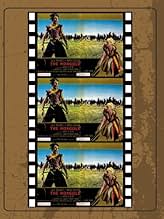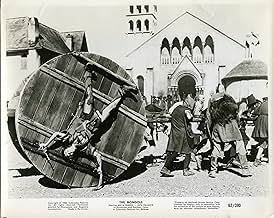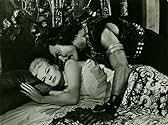अपनी भाषा में प्लॉट जोड़ेंDuring the Mongol invasion of Poland, a conflict between Mongol Emperor Genghis Khan and his oldest son Ogotai ensues when the former aims for peace and the latter itches for war and conques... सभी पढ़ेंDuring the Mongol invasion of Poland, a conflict between Mongol Emperor Genghis Khan and his oldest son Ogotai ensues when the former aims for peace and the latter itches for war and conquest.During the Mongol invasion of Poland, a conflict between Mongol Emperor Genghis Khan and his oldest son Ogotai ensues when the former aims for peace and the latter itches for war and conquest.
Lawrence Montaigne
- L'aleato di Stefano
- (as Lawrenc Montaigne)
Mario Colli
- Boris
- (बिना क्रेडिट के)
Andrej Gardenin
- Fencer
- (बिना क्रेडिट के)
Janine Hendy
- La danzatrice nell'harem
- (बिना क्रेडिट के)
फ़ीचर्ड समीक्षाएं
The story of this movie takes place in the middle ages at a time when Genghis Khan's Mongolian army was threatening Europe. It centers around the adventures of a Polish knight who wants to save the town Kraków from being taken by the cruel enemy.
The creators of the movie put much effort into the scenery and even more effort into the costumes. But they did not put any effort at all into the script or into acting. The plot is as simple-minded as if it had been invented by some twelve year old boys, playing cops and robbers. The dialog consists of stupid, hollow phrases. This alone would already make the movie a bad movie.
However its weaknesses go beyond that. The background music is not only unbearable symphonic rubbish. It is also inappropriately matched to the atmosphere of the individual scenes. Even the optical aspects that seem to have been the film maker's only focus are flawed. I do not have sufficient historical knowledge to judge about the historical correctness of costumes, weapons and other equipment. But I am quite sure that ordinary Polish women in the middle ages did not possess a hairstyle, makeup, and manicure like models in the early 1960's, especially if they were hiding from the Mongolian army in the marshland.
This having been said, it is almost unnecessary to mention that even the main story line is far from telling a true story about Genghis Khan's time.
There is no reason to watch this film, as long as you do not want to see how much can go wrong simultaneously with a single movie.
The creators of the movie put much effort into the scenery and even more effort into the costumes. But they did not put any effort at all into the script or into acting. The plot is as simple-minded as if it had been invented by some twelve year old boys, playing cops and robbers. The dialog consists of stupid, hollow phrases. This alone would already make the movie a bad movie.
However its weaknesses go beyond that. The background music is not only unbearable symphonic rubbish. It is also inappropriately matched to the atmosphere of the individual scenes. Even the optical aspects that seem to have been the film maker's only focus are flawed. I do not have sufficient historical knowledge to judge about the historical correctness of costumes, weapons and other equipment. But I am quite sure that ordinary Polish women in the middle ages did not possess a hairstyle, makeup, and manicure like models in the early 1960's, especially if they were hiding from the Mongolian army in the marshland.
This having been said, it is almost unnecessary to mention that even the main story line is far from telling a true story about Genghis Khan's time.
There is no reason to watch this film, as long as you do not want to see how much can go wrong simultaneously with a single movie.
For those of you who got a kick out of Mr. Palance's Attila the Hun in SIGN OF THE PAGAN this film gives you a better, new improved version of his unique brand of barbarity. This man's GOT to have a war or he'll just be miserable. He'll lie, cheat, steal, connive- do just anything in order to HAVE THAT WAR. This is type A personality taken to it's most outer extreme. You can really feel the almost unbearable frustration he seems to experience when his old dad Genghis Khan tells him that they're going to try for a peaceful solution with the Poles. Well, anyhow, it all ends badly for Jack (and dad). Anita Ekberg as a truly ice cold partner/lover of Jack's is fascinating to watch as well in a sort a somnambulistic way; she's pure deceit. And I was also rather entranced by the head Polish knight's seeming death wish in his relentless, driven fixed idea of obtaining peace with the Mongols. Discouraged at almost every turn, the son of a gun just would not give up and finally came out on top in the end (and got the girl, too). A good lesson in superhuman determination.
When Jack Palance signed on to do The Mongols an Italian produced epic shot in Yugoslavia he merely took out his former performance of as Attila The Hun ratcheted it up exponentially. When you're in a turkey like this all you can do is gobble gobble at the moon.
The only names we Americans will recognize are that of Palance playing Ogatai son of Genghis Khan and his lovely blond amazon wife played by Anita Ekberg. I will say this the writers did make provision for the fact that she clearly does not look like a Mongol and did mention that she was from a captive people. Perhaps a Viking settlement somewhere in Eastern Europe might explain it. I'll say this with that massive endowment of her's Anita looks good even in that Mongol armor. One fill figured girl she was.
When Palance is on there isn't a stick of furniture left standing. He is having one great old time overacting against the background of these continental cast members who sound stiff as usual with their dubbed voices. The Europeans have decided to sue for peace and have sent the film's nominal hero Franco Silva playing Stephen of Cracow as a peace emissary.
But Palance really gets his jollies with all the blood and guts and he doesn't want to stop the fighting. In this he's aided and abetted by Anita. So nice when husband and wife have a mutual interest. He and Anita do what they can to sabotage a cease fire.
In the end it's pulled out and western civilization itself is saved by a seasoned soldier taking home town advantage of the elements.
Jack Palance fans should get a real charge out of this film watching their guy dine on the scenery. The Mongols will give you quite a few unintentional laughs.
The only names we Americans will recognize are that of Palance playing Ogatai son of Genghis Khan and his lovely blond amazon wife played by Anita Ekberg. I will say this the writers did make provision for the fact that she clearly does not look like a Mongol and did mention that she was from a captive people. Perhaps a Viking settlement somewhere in Eastern Europe might explain it. I'll say this with that massive endowment of her's Anita looks good even in that Mongol armor. One fill figured girl she was.
When Palance is on there isn't a stick of furniture left standing. He is having one great old time overacting against the background of these continental cast members who sound stiff as usual with their dubbed voices. The Europeans have decided to sue for peace and have sent the film's nominal hero Franco Silva playing Stephen of Cracow as a peace emissary.
But Palance really gets his jollies with all the blood and guts and he doesn't want to stop the fighting. In this he's aided and abetted by Anita. So nice when husband and wife have a mutual interest. He and Anita do what they can to sabotage a cease fire.
In the end it's pulled out and western civilization itself is saved by a seasoned soldier taking home town advantage of the elements.
Jack Palance fans should get a real charge out of this film watching their guy dine on the scenery. The Mongols will give you quite a few unintentional laughs.
This was one of a number of low-brow peplums about ancient warrior tribes made in the wake of THE VIKINGS (1958) – this one even boasted a similarly rousing score by that film’s same composer, Mario Nascimbene. Others in this vein included THE COSSACKS (1960), THE TARTARS (1961) and ATTACK OF THE NORMANS (1962) – the latter being the only one in the bunch that I’ve watched, though I did lose the first one a couple of times on Italian TV.
Actually, this one turned out to be pretty good – and, I have to say, it lived up to the review on “Stracult” where special reference is made to its sequences of bloodthirsty action and sadism. Jack Palance gives the role of Ogotai – son of Asian potentate Genghis Khan – his eye-rolling all; he’s abetted by an equally evil Anita Ekberg (the mighty but battle-weary Khan himself perishes by her hand!). The unhistorical narrative involves the Mongols’ raid of Poland and, in particular, the attempts by one of the latter’s leading figures (Franco Silva) to negotiate a peace treaty with the Khan – a plan which Palance vehemently opposes and constantly schemes to thwart.
Being a relatively low-budget effort, the triple directorial credit might seem surprising: however, as the Italian credits themselves clearly indicate, this translates to being “A Film by Andre' De Toth” (implying that he was merely engaged in a supervisory capacity), “Directed by Leopoldo Savona”, and “Battle Sequences Staged by Riccardo Freda”. With this in mind, there are fewer of the latter than one would perhaps have appreciated – but these are nonetheless handled with the requisite gusto and grandeur. The rest of the film is largely taken up by various court intrigues on both sides of the fence but also a three-way Polish romance involving the aforementioned Franco Silva, Antonella Lualdi and Pierre Cressoy that tends to swamp Palance’s troubled relationship with his own wife!
As I said, the violence is really at the fore in this film – the Mongols themselves are memorably introduced on horseback dragging a statue of the Virgin Mary through the streets of a Polish city they’d just ransacked; besides, there are plenty of floggings (Ekberg herself lends a hand in the punishment of the perennially imperiled Lualdi), crucifixions (two men are even tied to the wheels of an advancing cart!), burnings at the stakes, etc. The finale, then, sees an Alexander NEVSKY (1938)-type strategy at work with the apparently fleeing Silva and his men luring the pursuing Mongol forces into a deadly swamp. The film was good enough almost to merit a *** rating from me…but, at 115 minutes, it’s quite a long haul – especially since it resorts too often to contrived (and repetitive) plotting.
Actually, this one turned out to be pretty good – and, I have to say, it lived up to the review on “Stracult” where special reference is made to its sequences of bloodthirsty action and sadism. Jack Palance gives the role of Ogotai – son of Asian potentate Genghis Khan – his eye-rolling all; he’s abetted by an equally evil Anita Ekberg (the mighty but battle-weary Khan himself perishes by her hand!). The unhistorical narrative involves the Mongols’ raid of Poland and, in particular, the attempts by one of the latter’s leading figures (Franco Silva) to negotiate a peace treaty with the Khan – a plan which Palance vehemently opposes and constantly schemes to thwart.
Being a relatively low-budget effort, the triple directorial credit might seem surprising: however, as the Italian credits themselves clearly indicate, this translates to being “A Film by Andre' De Toth” (implying that he was merely engaged in a supervisory capacity), “Directed by Leopoldo Savona”, and “Battle Sequences Staged by Riccardo Freda”. With this in mind, there are fewer of the latter than one would perhaps have appreciated – but these are nonetheless handled with the requisite gusto and grandeur. The rest of the film is largely taken up by various court intrigues on both sides of the fence but also a three-way Polish romance involving the aforementioned Franco Silva, Antonella Lualdi and Pierre Cressoy that tends to swamp Palance’s troubled relationship with his own wife!
As I said, the violence is really at the fore in this film – the Mongols themselves are memorably introduced on horseback dragging a statue of the Virgin Mary through the streets of a Polish city they’d just ransacked; besides, there are plenty of floggings (Ekberg herself lends a hand in the punishment of the perennially imperiled Lualdi), crucifixions (two men are even tied to the wheels of an advancing cart!), burnings at the stakes, etc. The finale, then, sees an Alexander NEVSKY (1938)-type strategy at work with the apparently fleeing Silva and his men luring the pursuing Mongol forces into a deadly swamp. The film was good enough almost to merit a *** rating from me…but, at 115 minutes, it’s quite a long haul – especially since it resorts too often to contrived (and repetitive) plotting.
I've wanted to watch this movie for a long time based on the performance of Jack Palance in a previous role as Atilla in "Sign of the Pagan". I wasn't disappointed in Palance's performance as Ogatai but as a whole this film was very inconsistent and horribly incorrect historically. To say the writers of this movie took liberties with history is an understatement. The great battle between the Mongols and the combined armies of Europe did take place, but not with the results described in the movie. In fact, the Mongols did have the opportunity to move much further westward into Europe, except by chance were diverted back home due to the death of the emperor and than later resumed their campaign toward the south/west and the Middle East, considered more attractive at this time in history. The movie does have some lavish costumes and epic battles, but it also often repeats the same footage over and over again. This movie actually had some potential with the amount of money it seemed to have in its production, but somebody dropped the ball in terms of editing, music and story. Blond haired Anita Ekberg as Ogatai's lover at first glance seems absurd, but plausible when you consider that the Mongols conquered all of Asia and most of Eastern Europe. Her acting is actually fairly good. The movie is worth seeing if your a fan of Jack Palance, his character of Ogatai is a unique one.
क्या आपको पता है
- ट्रिवियाPopularized by John Green's Crash Course YouTube series (three-second raid scene) every time he uses the phrase "The Mongols".
- गूफ़During an invasion of the Mongols a character is seen dressed in a sleeveless jacket defending another nailed to a wheel. Ogotai (Jack Palance) drags him down with his whip, only this time the character has lost his sleeveless leather jacket, and is wearing only a wide shirt.
- कनेक्शनFeatured in Crash Course: World History: The Agricultural Revolution (2012)
टॉप पसंद
रेटिंग देने के लिए साइन-इन करें और वैयक्तिकृत सुझावों के लिए वॉचलिस्ट करें
- How long is The Mongols?Alexa द्वारा संचालित
विवरण
- चलने की अवधि
- 1 घं 55 मि(115 min)
- पक्ष अनुपात
- 2.35 : 1
इस पेज में योगदान दें
किसी बदलाव का सुझाव दें या अनुपलब्ध कॉन्टेंट जोड़ें















